AI-Based Physical and Virtual Platform with 5-Layered Architecture for Sustainable Smart Energy City Development
Abstract
1. Introduction
1.1. Description of a Sustainable Smart Energy City (SSEC)
1.2. Current Problems Relating to Development of SECs
1.3. Proposed SSEC
- Problems: The components of a SEC are not linked to other technologies because current technology development focuses on unit elements of energy technology. This is because no standardized SECs have been established yet in energy fields.
- Solutions: For effective functioning of a SEC, smart system elements should function as stand-alone entities, as well as be compatible with other elements. The connections between all individual elemental technologies must be considered and developed prior to the development of the technology itself. This would lead to more feasible, rapid, and cost-effective development of SECs in future. Therefore, this study proposes a 5-layer architecture for analyzing the connectivity of technology elements before building a SEC.
- How do the energy elements that constitute the SECs link together to form an organic platform technically, economically, and socially?
- How can energy elements be organically linked to implement AI-based smart energy cities for intelligent energy efficiency management?
- Is it possible to build smart energy cities quickly and cost-effectively by organically-linking the SEC platform?
- Connectivity: Overall system connectivity can be strengthened by classifying the characters of energy element technologies in urban areas.
- Promptness: A SSEC can be built that responds quickly by establishing a cyclical structure based on a composite top-down and bottom-up platform.
- Manufacturing process and cost-effectiveness: Efficient SSECs can be built by mass-customization based manufacturing process based on a composite top-down and bottom-up platform.
- Guidelines for pre-analyzing obstacles and risk management: This platform provides guidance for pre-analyzing obstacles and managing risks when applying services [15].
2. Related Works
2.1. Sustainable Smart Energy City (SSEC)
2.2. Artificial Intelligence (AI)
2.3. Layering Architecture
2.4. Physical and Virtual Platform
2.5. Digital Twin
2.6. Mass-Customization
3. Proposed Architecture for Sustainable Smart Energy City (SSEC)
3.1. 5-Layer Based SEC Physical Platform Architecture
- Layer 1: Digital layer: data-based collection–transmission and analysis technology;
- Layer 2: Home and buildings layer: smart homes, buildings, and factories;
- Layer 3: Mobility layer: electric vehicles and smart mobility;
- Layer 4: Infrastructure layer: sensors, actuators, network infrastructure, and energy grid;
- Layer 5: Virtual Layer: energy optimization technology through simulation based on augmented reality/virtual reality (AR/VR) and digital twin technology.
3.2. 5-Layer Based SSEC Physical/Virtual Platform Architecture
3.2.1. Physical Platform (5-layers)
- Digital layer: A virtual cloud that stores data collected from the physical layer.
- Physical layer: The actual physical space of the SEC. Sensor networks are installed in the physical space to collect energy data (home/buildings, mobility, and infrastructure).
- Virtual layer: Provides business guidelines and an optimization model from the business platform to AI-based optimization of physical layer sensors and actuators
3.2.2. Virtual Platform
- Data platform: Manages data clouds stored in the digital layer.
- Network platform: Sensor and actuator network platform to be installed in the physical layer.
- Business platform: Provides business guidelines and an optimization model to managers and users through virtual simulation.
3.2.3. Data Center
- Classification: Receives data from the software platform and processes it as metadata through classification.
- Physical simulation: Visualizes physical modeling and simulation based on processed metadata.
- Virtual simulation: Digital-twin and augmented reality (AR)/VR-based virtual monitoring for optimization.
3.3. System Overview
- ①
- The hardware company manufactures IoT-based sensors and actuators and implements the system in the city.
- ②
- IoT-based sensors collect data based on edge computing through the implemented system and transmit them to the cloud.
- ③
- The cloud stores the data and sends it to the data center for monitoring.
- ④
- The data center processes and monitors the data.
- ⑤
- The data center conducts a physical simulation to visually confirm the processed data, and also conducts a virtual simulation to enable intelligent optimization.
- ⑥
- This provides a model for ensuring physical control through physical simulations.
- ⑦
- This provides an optimization model through virtual simulations.
- ⑧
- By providing an optimization model, the service/business guidelines for optimal system installation in the city can be provided to managers and users, and operators and users cyclically perform energy system AI-based optimal management.
3.4. 5-Layer Architecture Connection Flow Chart for AI-Based Management and Optimization
- ①
- Data → SEC data collection
- ②
- Platform→ SEC platform
- ③
- Supply→ Eco-friendly energy supply
- ④
- Optimization: → Smart energy demand prediction and management
- ⑤
- Service → Smart energy service/business
- ⑥
- Policy → System improvement and dissemination by SEC platform
3.5. SEC Physical/Virtual Platform Architecture
3.6. What Is the Artificial Intelligence (AI)-Based Optimal Management in SSEC?
4. Scenarios
4.1. Physical/Virtual Connection Scenarios
4.2. Scenarios
4.2.1. Scenario 1: Smart Clean Zero Energy City platform
4.2.2. Scenario 2: Collaborative Smart Energy Prosumer Platform
| Service Scenario #1 Scenario details |
Smart Clean Zero Energy City
|
| Service Scenario #2 Scenario details |
Collaborative smart energy prosumer platform
|
5. Results (Economic Analysis)
5.1. Research Method
5.2. Economic Analysis
5.2.1. Method of Economic Analysis
- Economic analysis was conducted by measuring and comparing the costs and benefits of applying a smart system (Figure 13).
- The benefits include reduced social costs, which are mitigated through energy savings.
- It can thus be said that there is a difference between the value generated when the smart system is not applied and the energy saving value when the system is applied.
5.2.2. Economic Analysis Process
- (1)
- Total installation cost during the installation of smart building system in Korea was estimated. This further involved:
- Analysis on the status of buildings in Korea: Estimation of the total area of domestic buildings;
- Estimation of total installation cost when installing smart building system in Korea;
- Additionally, estimation of installation cost when installing V2G/EV.
- (2)
- Economic benefit cost when installing smart building system
- Estimation of reduction rate of total energy use cost by smart building system.
- (3)
- Economic benefits when applying the proposed architecture
- Estimation of reduction cost of total smart system installation [11];
- Estimation of reduction cost of total energy use by AI and V2G/EV.
- (4)
- Return on Investment (ROI) was calculated as;
- ROI [43] = (smart system installation cost (SSIC) − expected cost saving through proposed architecture (ECSP))/total expected saving cost through system installation (T − ESCS).
5.3. Economic Analysis of Applying Smart Building System in SECs
5.3.1. Total Installation Cost When Installing Smart Building System in Korea
Analysis on the Status of Buildings in Korea: Estimation of the Total Area of Domestic Buildings
Average Cost of Smart Building System (Module)
Total Installation Cost of Installing Smart Building System in Korea
5.3.2. Economic Benefits of Installation of Smart Building System
5.3.3. Economic Benefits when Applying the Proposed Architecture
5.4. Result
5.4.1. Return on Investment (ROI)
- (1)
- Typical payback period when applying system to domestic buildings (ROI-S)
- ROI-S = = 17.86/2.09 = 8.52 (year)
- (2)
- Payback period when applying the proposed system architecture (ROI-P)
- ROI-P = = (17.86 − 2.83)/2.09 = 7.16 (year)
5.4.2. Simulation Result
6. Conclusions
6.1. Implications
- Connectivity: As emphasized in this paper, connectivity is the most important element of a SEC platform. This paper presents an analysis of the interconnection between technology elements of a SEC. The system is designed to enhance the linkage of the entire energy system within the city through classification and analysis of the energy characteristics therein. The cyclic structure of the SEC platform is also shown, and it is considered possible to achieve sustainable development through a collaboration between researchers, operators, and users within the city.
- The rapid speed in which the platform can be developed and applied: The second important element of the SEC platform presented in this paper is rapid speed of development. The SEC platform is based on a complex top-down and bottom-up cyclic structure, and it is possible to create a SEC infrastructure rapidly in order to quickly provide an organized SEC through collaboration between various operators and users [9].
- Manufacturing process and cost effectiveness: Based on the combined top-down and bottom-up platform, it is possible to build mass-customization-based SEC infrastructure that is cost effective to implement and use [11]. Through an analysis of the links between software and hardware providers, it is expected that costs can be reduced by the mass-customization and manufacture of sensors and actuators. This would also enable small businesses and start-up companies, as well as large enterprises, to participate and achieve balanced economic development.
- Guidelines for pre-analyzing obstacles and risk management: Guidelines for applying services will be provided through physical and virtual simulations based on digital twin-based analysis and risk management of the SEC infrastructure [15].
6.2. Future Prospects
- Rapid urban establishment: Parker, Van Alstyne, and Choudary [9] pointed out that through platform, the development of smart and sophisticated IT technology can achieve speed and efficiency beyond time and space limitations. It is anticipated that the proposed top-down and bottom-up platform with a cyclic structure will contribute to the rapid and efficient construction of smart energy cities in the future.
- Obstacle analysis/risk prevention: This architecture ensures obstacle analysis/risk prevention by employing rapid and cost-effective measures prior to the building of SC, while also providing a preliminary analysis of the construction. Based on the digital twin, risk analysis and its prevention measures are taken into account in advance, and SC plans verified accordingly [15].
- Improved employment efficiency: Mass-customization of the proposed architecture makes it possible to construct smart systems specifically for domestic and industrial applications. This can reduce manufacturing costs and lead to the development of new industries. New small-scale localized start-ups and job opportunities [52] are expected in various domestic industries like information and communication technology (ICT)/IoT involving manufacturing, transportation, service industries, new HW/SW derivatives, and consulting.
Author Contributions
Funding
Acknowledgments
Conflicts of Interest
References
- McLaren, D.; Agyeman, J. Sharing Cities: A Case for Truly Smart and Sustainable Cities; MIT Press: Cambridge, MA, USA, 2015; ISBN 978-0-262-02972-8. [Google Scholar]
- Nielsen, P.S.; Amer, S.B.; Halsnæs, K. Definition of Smart Energy City and State of the Art of 6 Transform Cities Using Key Performance Indicators; 2013. Available online: https://orbit.dtu.dk/fedora/objects/orbit:126320/datastreams/file_384a28a6-01c9-4940-b04f-20558b2ebeb1/content (accessed on 2 February 2019).
- Defining a Smart Energy City. Available online: https://wsco-online.com/defining-a-smart-energy-city/ (accessed on 20 February 2017).
- Pezzutto, S.; Vaccaro, R.; Zambelli, P.; Mosannenzadeh, F.; Bisello, A.; Vettorato, D. FP7 SINFONIA project, Deliverable 2.1 SWOT analysis report of the refined concept/baseline (SINFONIA deliverables). Eur. Acad. Bolzano 2015. [Google Scholar]
- Höjer, M.; Wangel, J. Smart sustainable cities: Definition and challenges. In ICT Innovations for Sustainability; Springer: New York, NY, USA, 2015; pp. 333–349. ISBN 978-3-319-09227-0. [Google Scholar]
- Merriam-Webster. Available online: https://www.merriam-webster.com/dictionary/sustainable (accessed on 1 July 2019).
- Hayashi, Y.; Fujimoto, Y.; Ishii, H.; Takenobu, Y.; Kikusato, H.; Yoshizawa, S.; Amano, Y.; Tanabe, S.-I.; Yamaguchi, Y.; Shimoda, Y. Versatile Modeling Platform for Cooperative Energy Management Systems in Smart Cities. Proc. IEEE 2018, 106, 594–612. [Google Scholar] [CrossRef]
- Allam, Z.; Newman, P. Redefining the Smart City: Culture, Metabolism and Governance. Smart Cities 2018, 1, 4–25. [Google Scholar] [CrossRef]
- Parker, G.G.; Van Alstyne, M.W.; Choudary, S.P. Platform Revolution: How Networked Markets are Transforming the Economyand How to Make Them Work for You; WW Norton & Company: New York, NY, USA, 2016; ISBN 9780393249132. [Google Scholar]
- Shahidehpour, M.; Li, Z.; Ganji, M. Smart Cities for a Sustainable Urbanization: Illuminating the Need for Establishing Smart Urban Infrastructures. IEEE Electrif. Mag. 2018, 6, 16–33. [Google Scholar] [CrossRef]
- Park, S.; Park, S.; Byun, J.; Park, S. Design of a mass-customization-based cost-effective Internet of Things sensor system in smart building spaces. Int. J. Distrib. Sens. Netw. 2016, 12, 1550147716660895. [Google Scholar] [CrossRef]
- Krylovskiy, A.; Jahn, M.; Patti, E. Designing a smart city internet of things platform with microservice architecture. In Proceedings of the 2015 3rd International Conference on Future Internet of Things and Cloud, Rome, Italy, 24–26 August 2015; pp. 25–30. [Google Scholar]
- Mehmood, Y.; Ahmad, F.; Yaqoob, I.; Adnane, A.; Imran, M.; Guizani, S. Internet-of-things-based smart cities: Recent advances and challenges. IEEE Commun. Mag. 2017, 55, 16–24. [Google Scholar] [CrossRef]
- Komninos, N.; Bratsas, C.; Kakderi, C.; Tsarchopoulos, P. Smart city ontologies: Improving the effectiveness of smart city applications. J. Smart Cities 2015, 1, 31–46. [Google Scholar] [CrossRef]
- Boschert, S.; Rosen, R. Digital twin—The simulation aspect. In Mechatronic Futures; Springer: New York, NY, USA, 2016; pp. 59–74. ISBN 978-3-319-32154-7. [Google Scholar]
- Navidi, A.; Khatami, F.A.-S. Energy management and planning in smart cities. Cired-Open Access Proc. J. 2017, 2017, 2723–2725. [Google Scholar] [CrossRef]
- Ejaz, W.; Naeem, M.; Shahid, A.; Anpalagan, A.; Jo, M. Efficient energy management for the internet of things in smart cities. IEEE Commun. Mag. 2017, 55, 84–91. [Google Scholar] [CrossRef]
- Brundu, F.G.; Patti, E.; Osello, A.; Del Giudice, M.; Rapetti, N.; Krylovskiy, A.; Jahn, M.; Verda, V.; Guelpa, E.; Rietto, L. IoT Software Infrastructure for Energy Management and Simulation in Smart Cities. IEEE Trans. Ind. Inform. 2017, 13, 832–840. [Google Scholar] [CrossRef]
- Allam, Z.; Newman, P. Economically Incentivising Smart Urban Regeneration. Case Study of Port Louis, Mauritius. Smart Cities 2018, 1, 53–74. [Google Scholar] [CrossRef]
- Poole, D.L.; Mackworth, A.K.; Goebel, R. Computational Intelligence: A Logical Approach; Oxford University Press: New York, NY, USA, 1998; Volume 1, ISBN 978-0-19510-270-3. [Google Scholar]
- Kaplan, A.; Haenlein, M. Siri, Siri, in my hand: Who’s the fairest in the land? On the interpretations, illustrations, and implications of artificial intelligence. Bus. Horiz. 2019, 62, 15–25. [Google Scholar] [CrossRef]
- Khan, S.; Paul, D.; Momtahan, P.; Aloqaily, M. Artificial intelligence framework for smart city microgrids: State of the art, challenges, and opportunities. In Proceedings of the 2018 Third International Conference on Fog and Mobile Edge Computing (FMEC), Barcelona, Spain, 23–26 April 2018; pp. 283–288. [Google Scholar]
- Allam, Z. Achieving Neuroplasticity in Artificial Neural Networks through Smart Cities. Smart Cities 2019, 2, 118–134. [Google Scholar] [CrossRef]
- Allam, Z. The emergence of anti-privacy and control at the nexus between the concepts of safe city and smart city. Smart Cities 2019, 2, 96–105. [Google Scholar] [CrossRef]
- Zdraveski, V.; Mishev, K.; Trajanov, D.; Kocarev, L. Iso-standardized smart city platform architecture and dashboard. IEEE Pervasive Comput. 2017, 16, 35–43. [Google Scholar] [CrossRef]
- Sholla, S.; Naaz, R.; Chishti, M.A. Ethics aware object oriented smart city architecture. China Commun. 2017, 14, 160–173. [Google Scholar] [CrossRef]
- Ahlgren, B.; Hidell, M.; Ngai, E.C.-H. Internet of things for smart cities: Interoperability and open data. IEEE Internet Comput. 2016, 20, 52–56. [Google Scholar] [CrossRef]
- Pereira, J.; Ricardo, L.; Luís, M.; Senna, C.; Sargento, S. Assessing the reliability of fog computing for smart mobility applications in VANETs. Future Gener. Comput. Syst. 2019, 94, 317–332. [Google Scholar] [CrossRef]
- Postranecky, M.; Svitek, M.; Zambrano, E.C. SynopCity© Virtual HUB-A Testbed for Smart Cities. IEEE Intell. Transp. Syst. Mag. 2018, 10, 50–57. [Google Scholar] [CrossRef]
- Lv, Z.; Yin, T.; Zhang, X.; Song, H.; Chen, G. Virtual Reality Smart City Based on WebVRGIS. IEEE Internet Things J. 2016, 3, 1015–1024. [Google Scholar] [CrossRef]
- Prendinger, H.; Gajananan, K.; Zaki, A.B.; Fares, A.; Molenaar, R.; Urbano, D.; van Lint, H.; Gomaa, W. Tokyo virtual living lab: Designing smart cities based on the 3d internet. IEEE Internet Comput. 2013, 17, 30–38. [Google Scholar] [CrossRef]
- Mohammadi, N.; Taylor, J.E. Smart city digital twins. In Proceedings of the 2017 IEEE Symposium Series on Computational Intelligence (SSCI), Honolulu, HI, USA, 27 November–1 December 2017; pp. 1–5. [Google Scholar]
- Alptekinoğlu, A.; Corbett, C.J. Mass customization vs. mass production: Variety and price competition. Manuf. Serv. Oper. Manag. 2008, 10, 204–217. [Google Scholar] [CrossRef]
- Davis, S.M. Future perfect. In Human Resource Management in International Firms; Springer: New York, NY, USA, 1990; pp. 18–28. [Google Scholar]
- Pezzutto, S.; De Felice, M.; Fazeli, R.; Kranzl, L.; Zambotti, S. Status Quo of the Air-Conditioning Market in Europe: Assessment of the Building Stock. Energies 2017, 10, 1253. [Google Scholar] [CrossRef]
- Ürge-Vorsatz, D.; Cabeza, L.F.; Serrano, S.; Barreneche, C.; Petrichenko, K.J.R.; Reviews, S.E. Heating and cooling energy trends and drivers in buildings. Renew. Sustain. Energy Rev. 2015, 41, 85–98. [Google Scholar] [CrossRef]
- Heating & Cooling. Available online: https://www.irena.org/heatingcooling (accessed on 31 January 2018).
- Pezzutto, S.; Fazeli, R.; De Felice, M.; Sparber, W. Future development of the air-conditioning market in Europe: An outlook until 2020. Wiley Interdiscip. Rev. Energy Environ. 2016, 5, 649–669. [Google Scholar] [CrossRef]
- Santamouris, M. Cooling the cities—A review of reflective and green roof mitigation technologies to fight heat island and improve comfort in urban environments. Sol. Energy 2014, 103, 682–703. [Google Scholar] [CrossRef]
- Norton, B.A.; Coutts, A.M.; Livesley, S.J.; Harris, R.J.; Hunter, A.M.; Williams, N.S.G. Planning for cooler cities: A framework to prioritise green infrastructure to mitigate high temperatures in urban landscapes. Landsc. Urban Plan. 2015, 134, 127–138. [Google Scholar] [CrossRef]
- How Cities Are Getting Smart Using Artificial Intelligence. Available online: https://www.forbes.com/sites/tomvanderark/2018/06/26/how-cities-are-getting-smart-using-artificial-intelligence/amp/ (accessed on 26 Jun 2018).
- Fukumizu, K. Geometry of neural networks: Natural gradient for learning. In Handbook of Biological Physics; Elsevier: Amsterdam, The Netherlands, 2001; Volume 4, pp. 731–769, 1383–8121. [Google Scholar]
- Payback Period, Investopedia. Available online: https://www.investopedia.com/terms/p/paybackperiod.asp (accessed on 20 May 2019).
- Ministry of Land, Infrastructure and Transport. Available online: http://www.molit.go.kr/portal.do (accessed on 1 February 2017).
- STATISTICS KOREA. Available online: http://www.index.go.kr/potal/main/EachDtlPageDetail.do?idx_cd=1226 (accessed on 1 January 2019).
- Power Data Open Potal System. Available online: http://home.kepco.co.kr/kepco/BD/BDBAPP001/BDBAPP001.do?menuCd=FN33020101#clickExcel (accessed on 1 October 2018).
- Byun, J.; Park, S.; Kang, B.; Hong, I.; Park, S. Design and implementation of an intelligent energy saving system based on standby power reduction for a future zero-energy home environment. IEEE Trans. Consum. Electron. 2013, 59, 507–514. [Google Scholar] [CrossRef]
- Kim, J.; Byun, J.; Jeong, D.; Choi, M.-I.; Kang, B.; Park, S. An IoT-based home energy management system over dynamic home area networks. Int. J. Distrib. Sens. Netw. 2015, 11, 828023. [Google Scholar] [CrossRef]
- Byun, J.; Park, S. Development of a self-adapting intelligent system for building energy saving and context-aware smart services. IEEE Trans. Consum. Electron. 2011, 57, 90–98. [Google Scholar] [CrossRef]
- Høj, J.; Juhl, L.; Lindegaard, S. V2G—An Economic Gamechanger in E-Mobility? World Electr. Veh. J. 2018, 9, 35. [Google Scholar] [CrossRef]
- Liu, Y.; Yang, C.; Jiang, L.; Xie, S.; Zhang, Y. Intelligent Edge Computing for IoT-Based Energy Management in Smart Cities. IEEE Netw. 2019, 33, 111–117. [Google Scholar] [CrossRef]
- Lee, J.; Kee, C.J.; Kim, D.; Kim, C.; Choi, J.; Lee, D. SW Convergence Strategy in Manufacturing/Service Industry: Software and Systems Product Line (SSPL). J. Inf. Technol. Serv. 2012, 11, 295–308. [Google Scholar] [CrossRef]
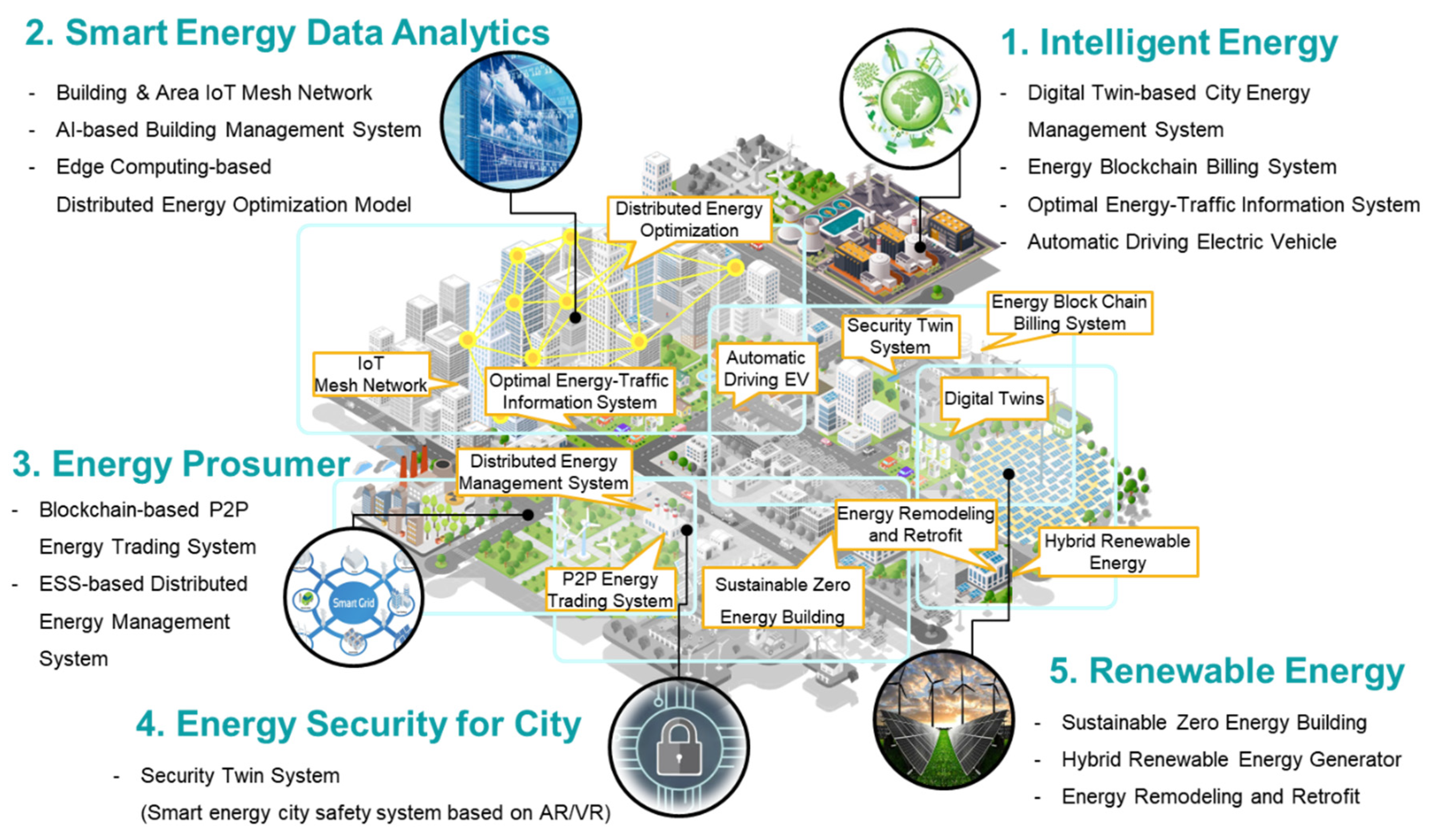
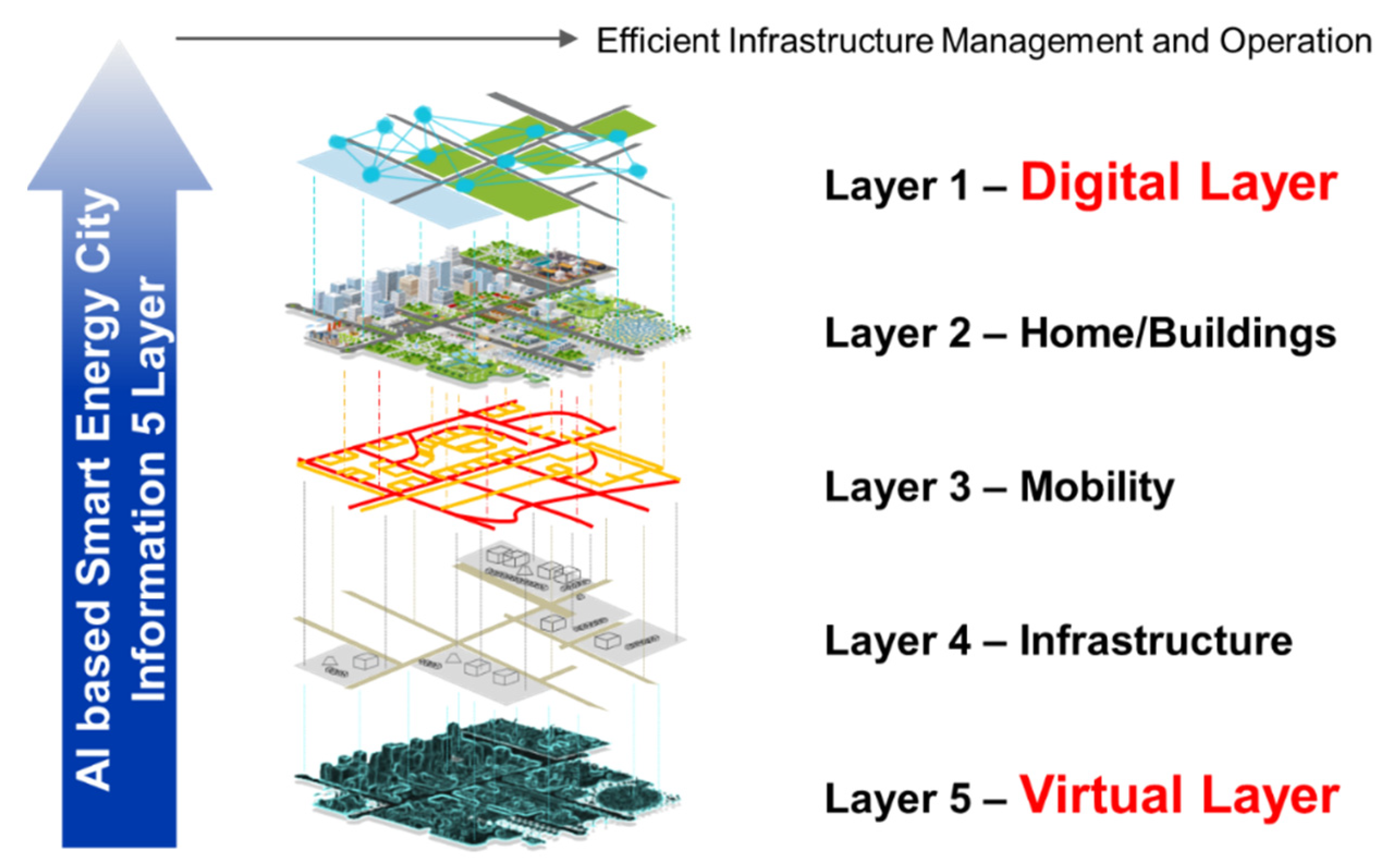
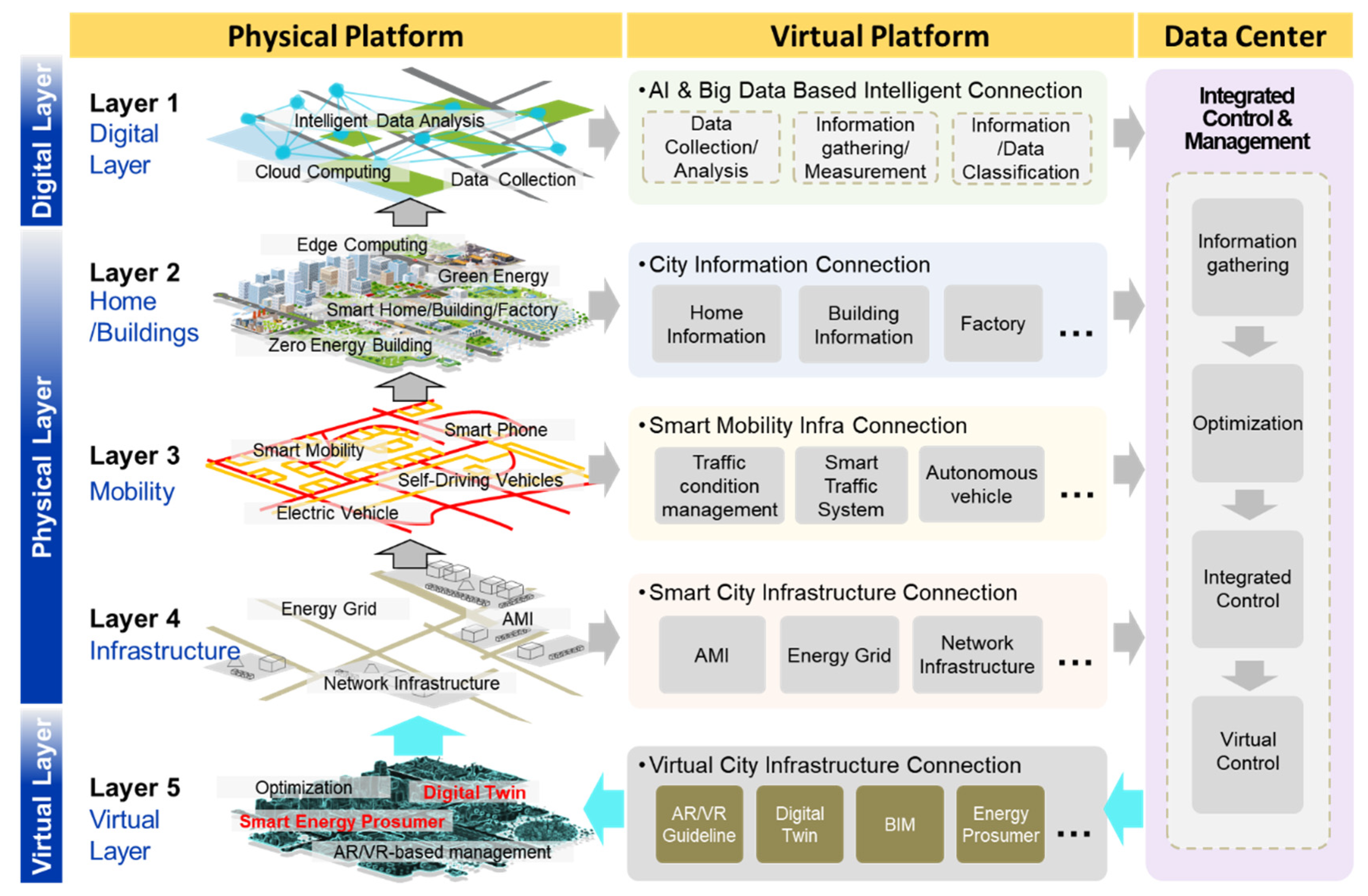
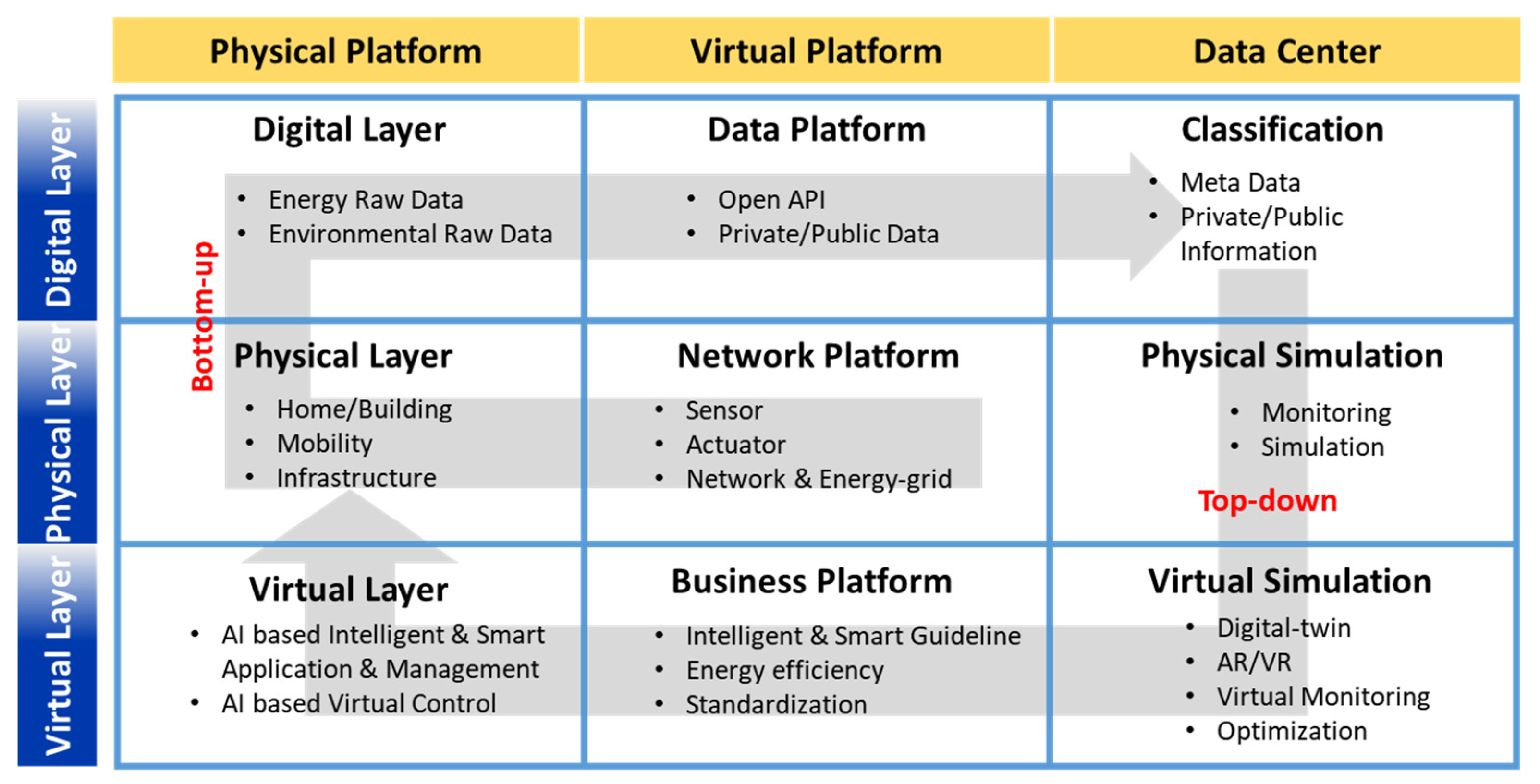

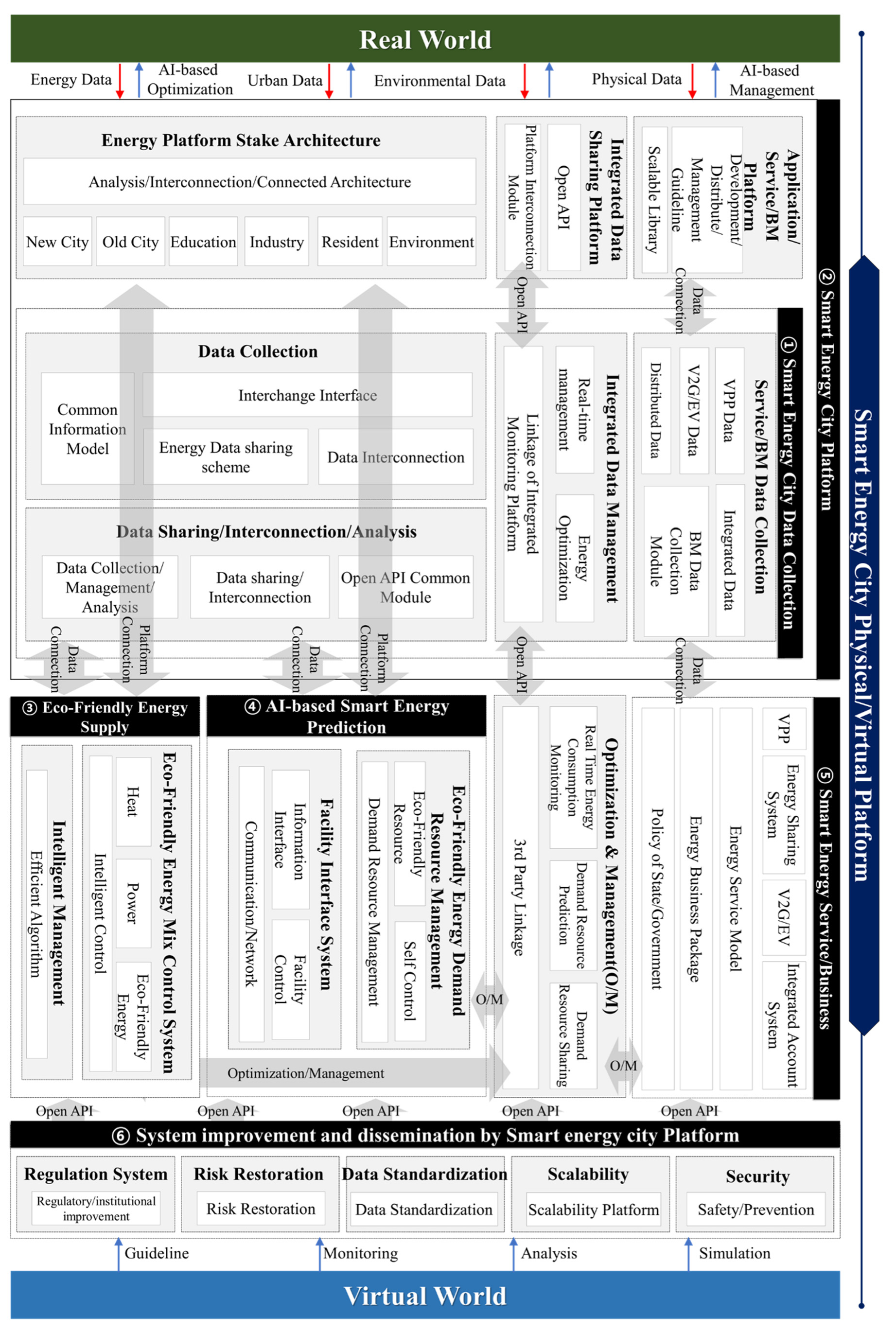
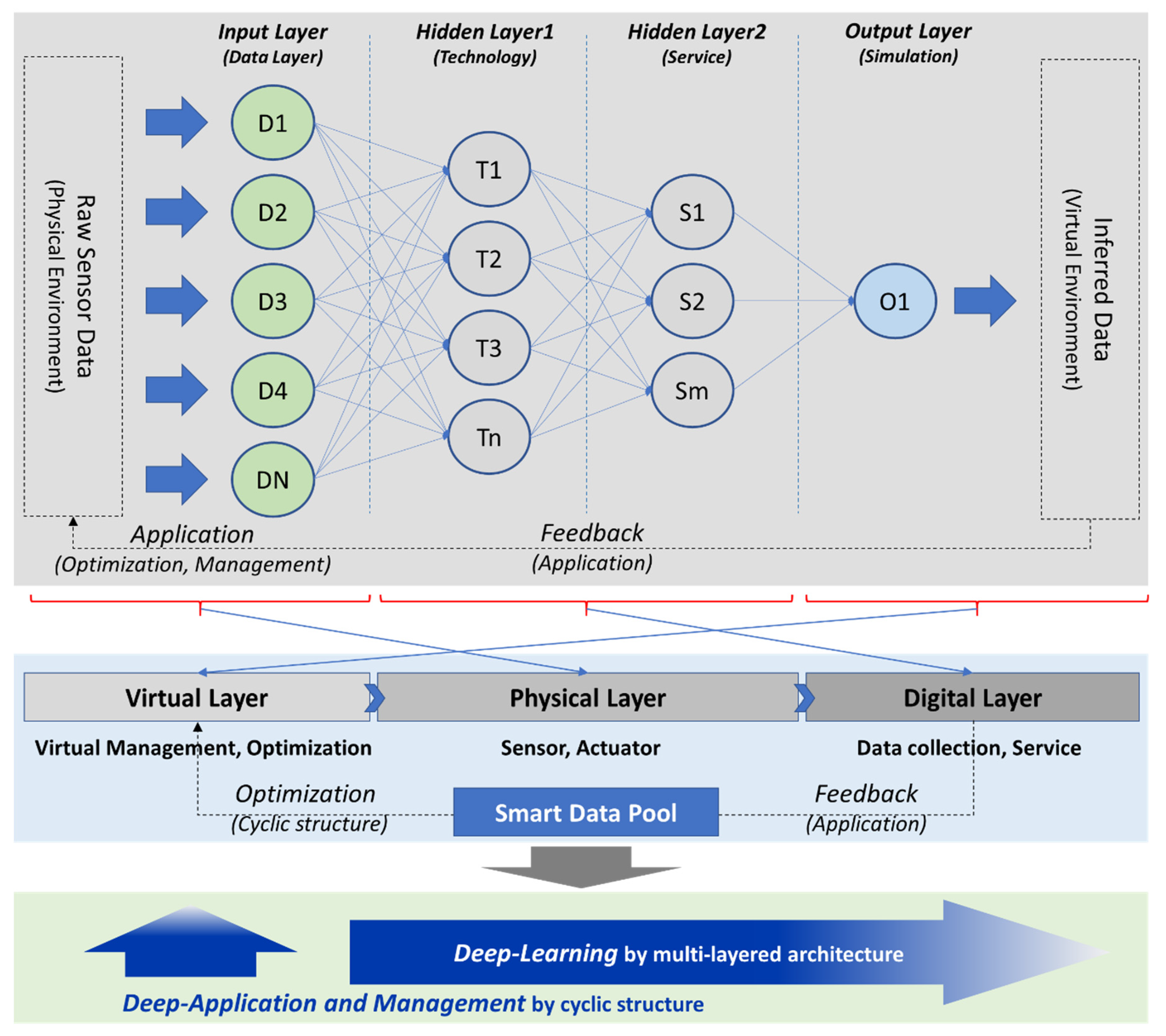
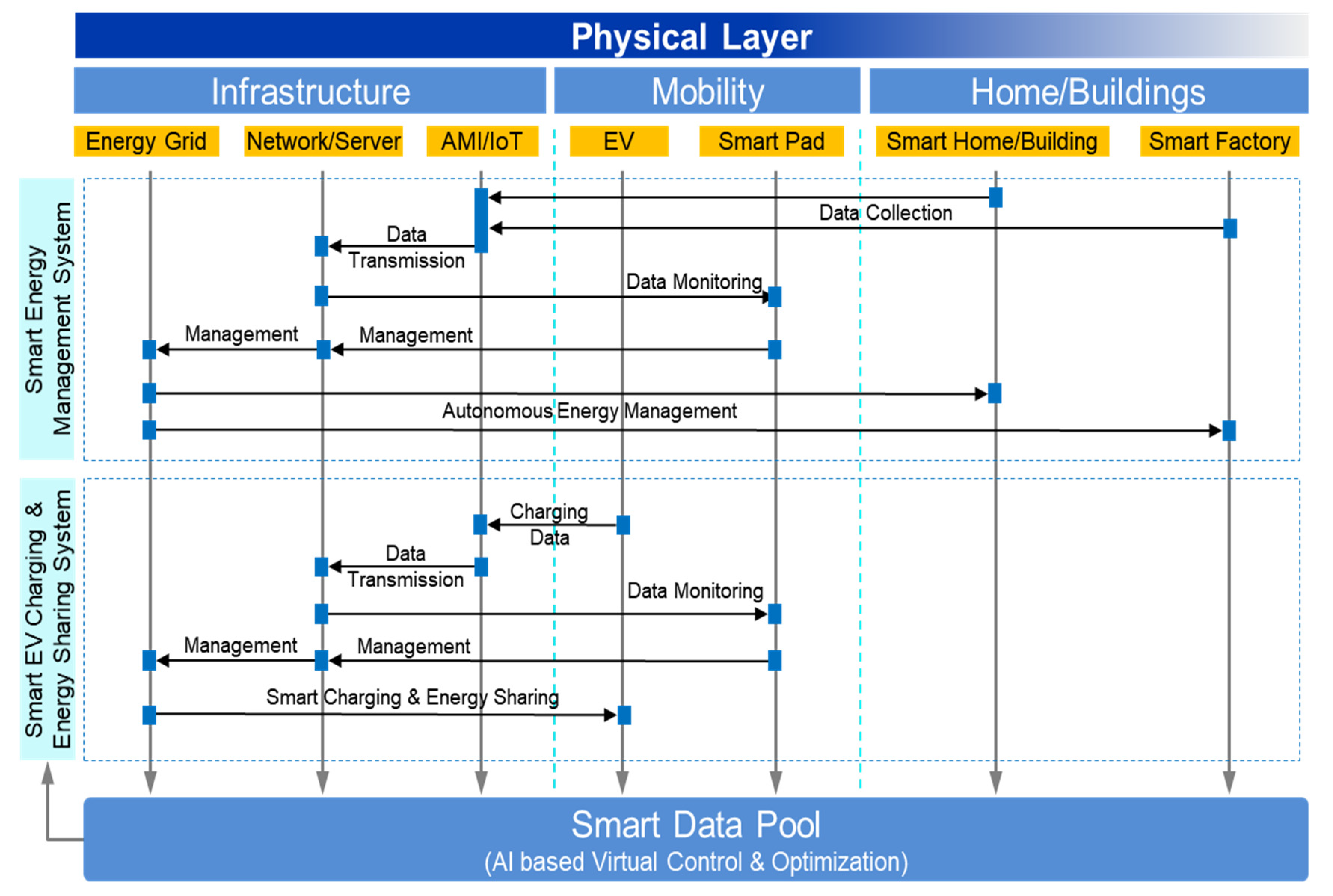
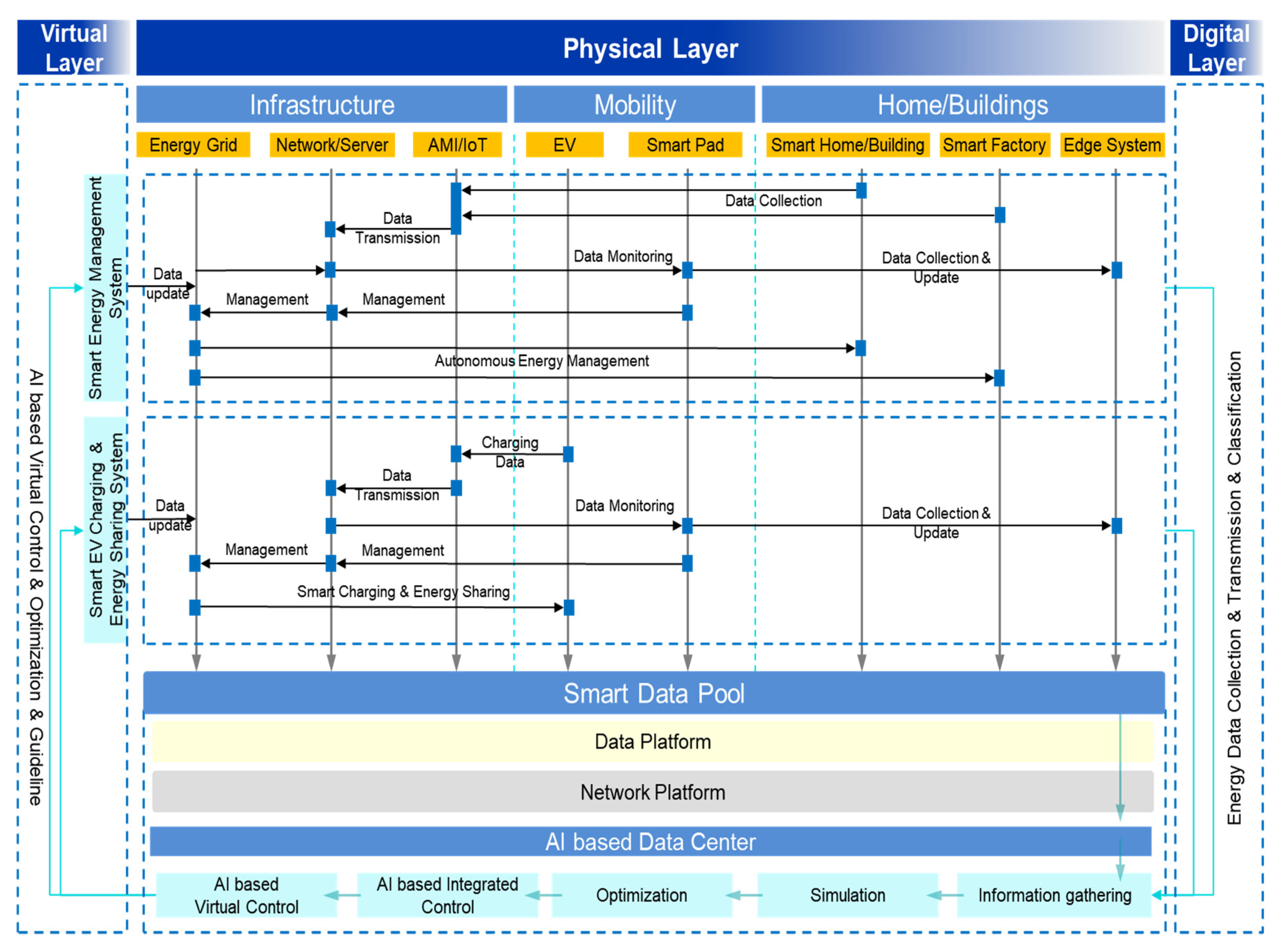
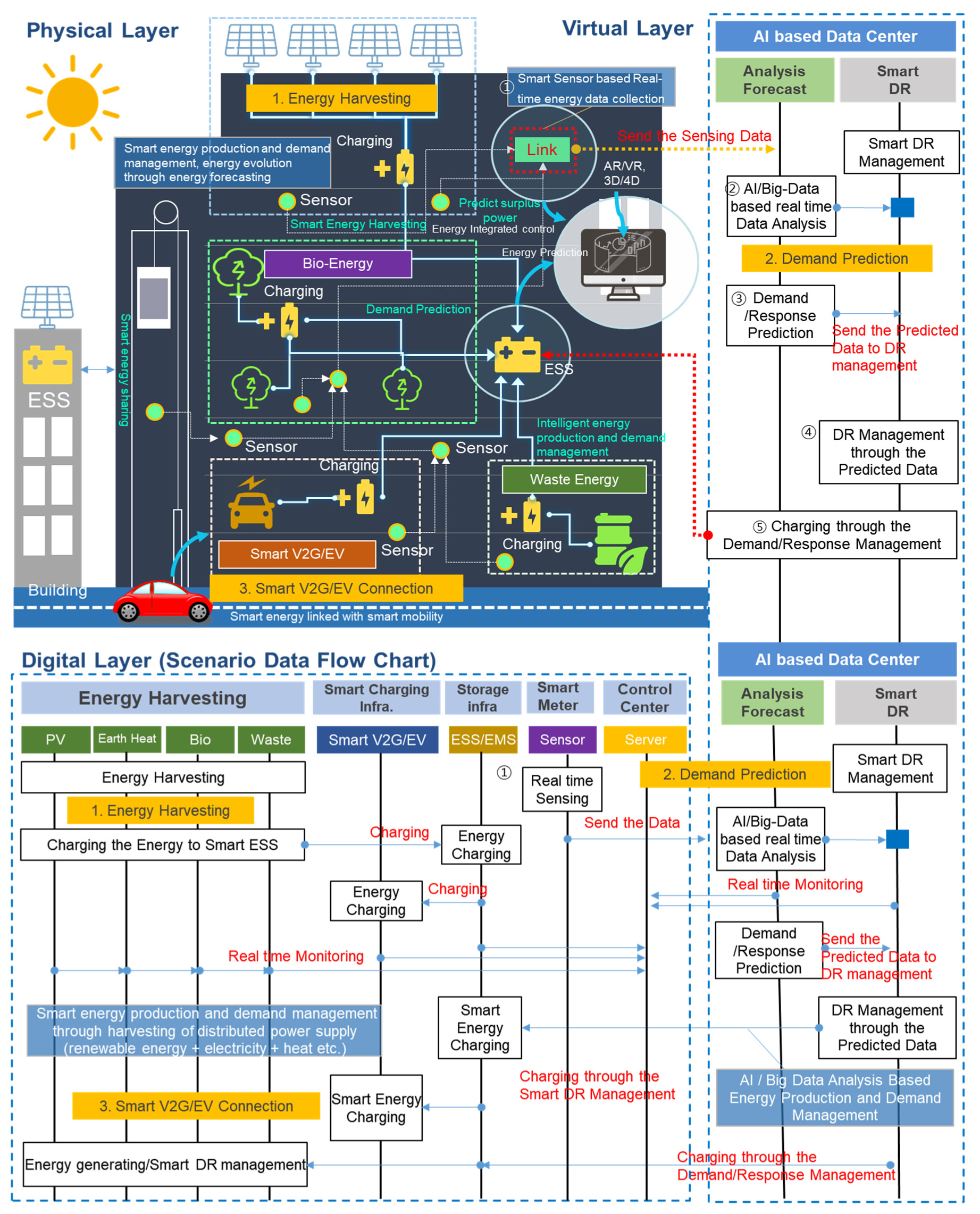
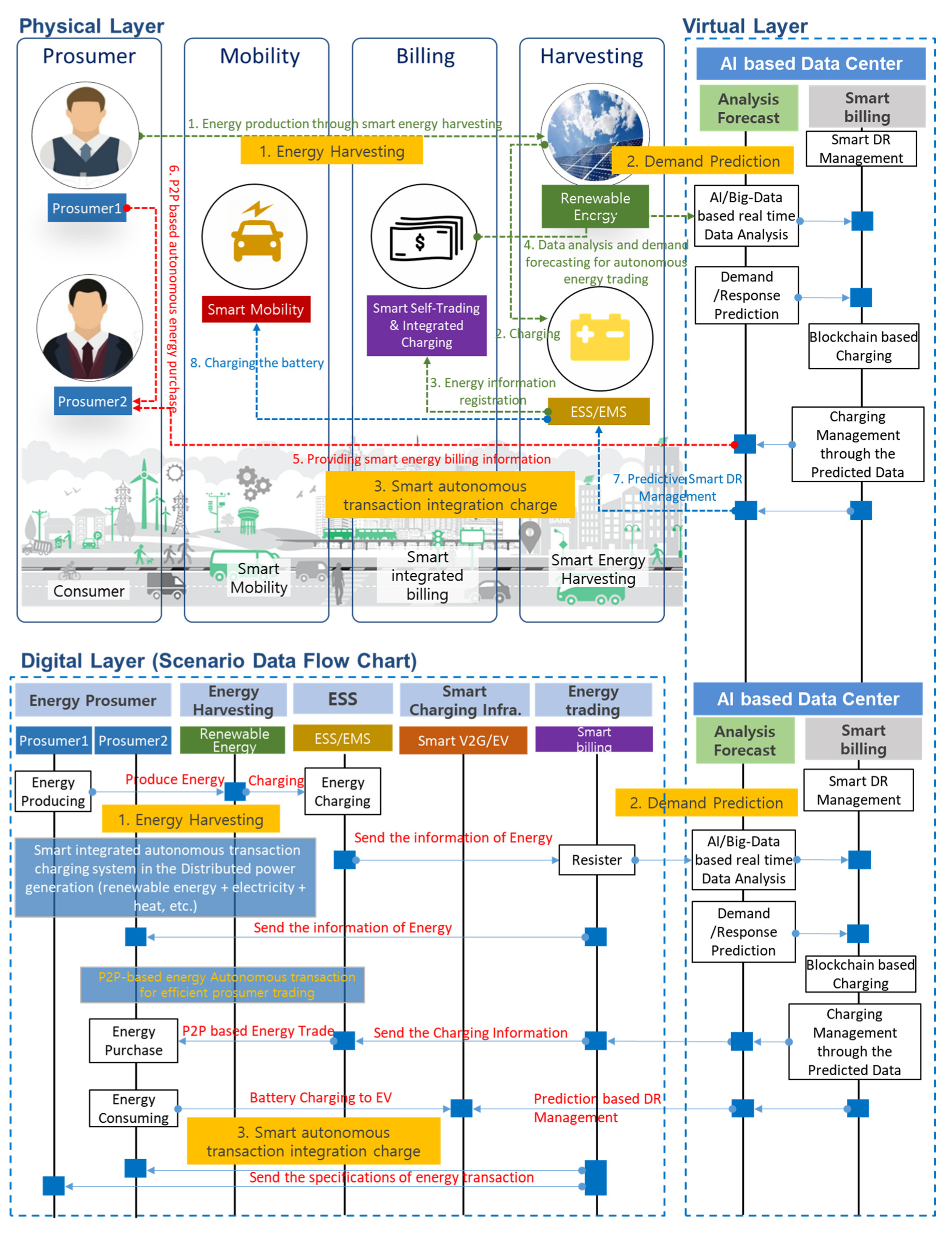
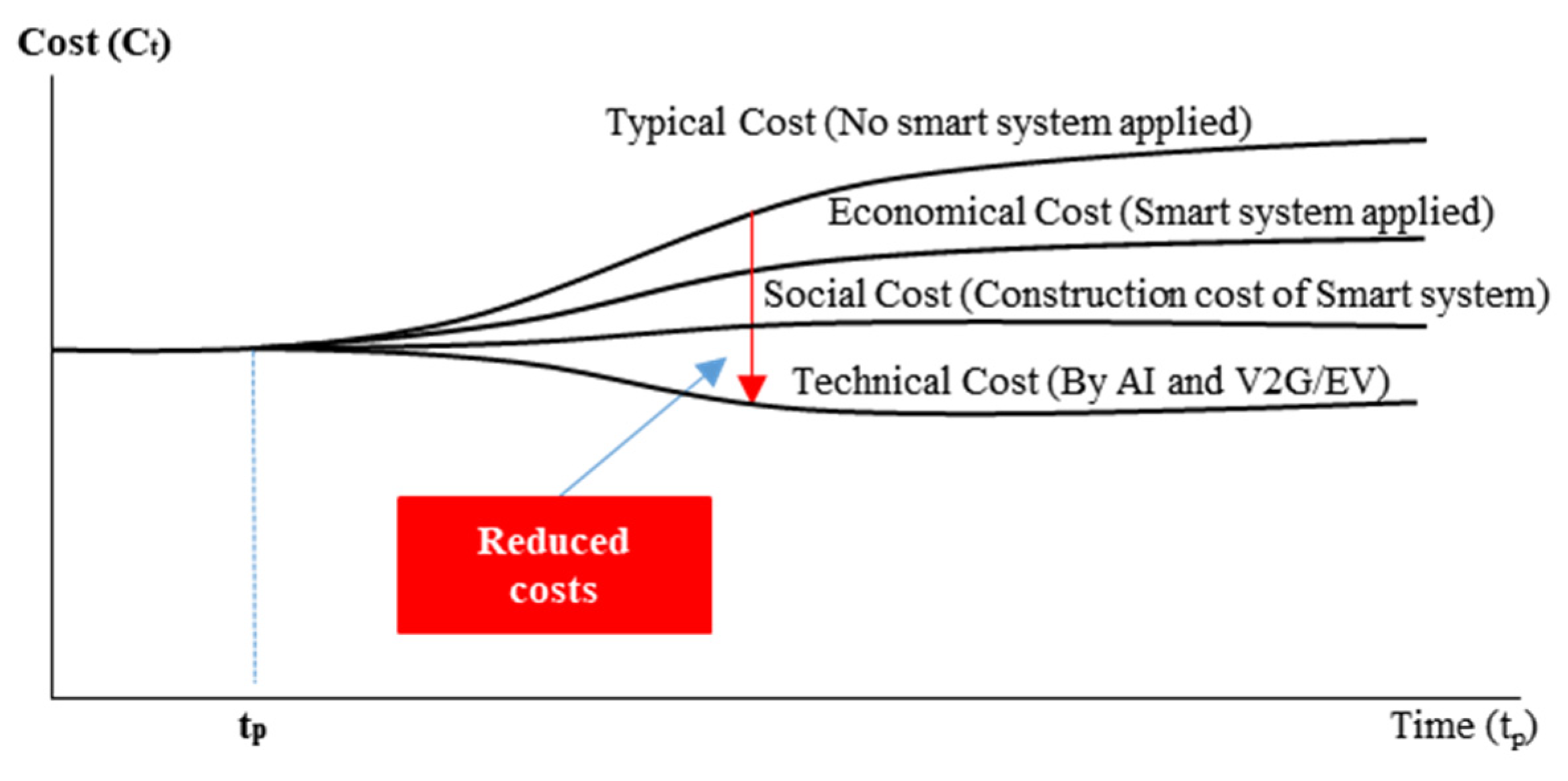
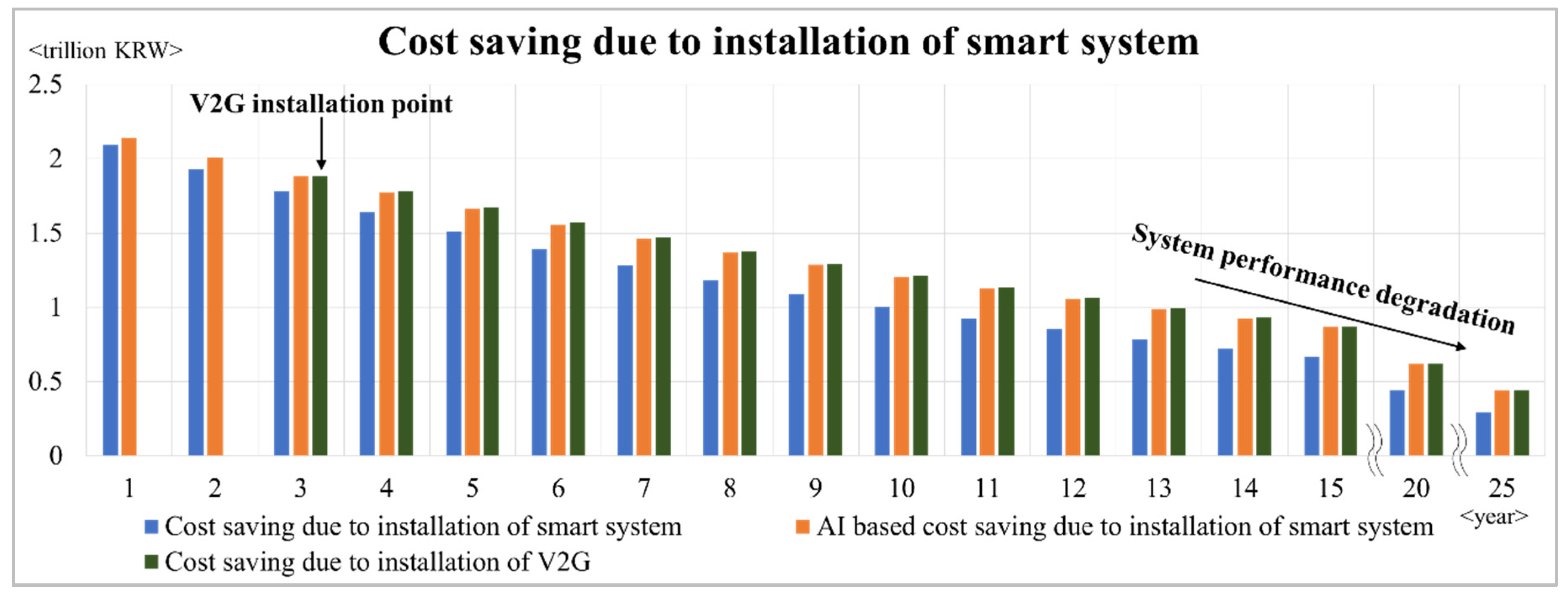
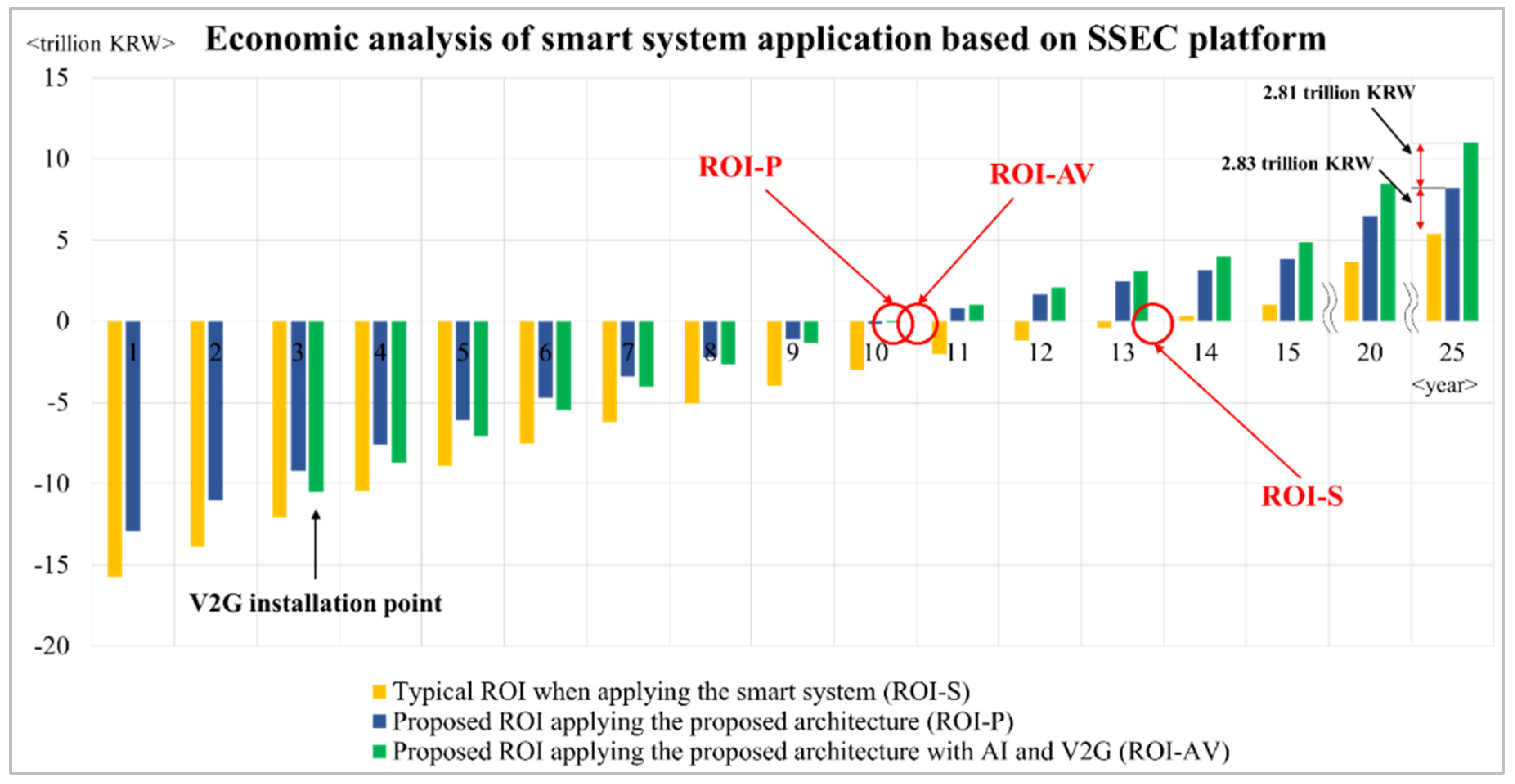
| Author(s) | Description | Purpose | Category | Novelty (Keywords) | |||||
|---|---|---|---|---|---|---|---|---|---|
| SO | T | EC | |||||||
| S | P | A | DS | E | L | ||||
| Navidi, A. et al. (2017) | Energy management and planning in smart cities | Energy consumption model planning in smart cities | √ | √ | √ | Energy efficiency model | |||
| Ejaz, W. et al. (2017) | Efficient energy management for the internet of things in smart cities | IoT-based EMS for smart cities | √ | IoT-based EMS | |||||
| Brundu, F.G. et al. (2017) | IoT software infrastructure for energy management and simulation in smart cities | IoT based simulation for smart cities | √ | √ | IoT-based simulation | ||||
| Allam, Z. et al. (2018) | Economically incentivising smart urban regeneration | Propose a smart urban regeneration model | √ | √ | √ | Smart urban regeneration model | |||
| Hayashi, Y. et al. (2018) | Versatile modeling platform for cooperative energy management systems in smart cities | Modeling a platform including cooperative EMSs | √ | √ | √ | Platform-based smart cities | |||
| Khan, S. et al. (2018) | Artificial intelligence framework for smart city microgrids | Scalable deep-learning based framework in microgrid | √ | √ | √ | √ | Scalable framework | ||
| Allam, Z. (2019) | Achieving neuroplasticity in artificial neural networks through smart cities | Artificial neural networks based smart city modeling | √ | √ | √ | AI-based smart city modeling | |||
| Shahidehpour, M. et al. (2018) | Smart cities for a sustainable urbanization | Illuminating the need for establishing smart urban infrastructures | √ | √ | √ | Sustainable smart city | |||
| Zdraveski, V. et al. (2017) | Iso-standardized smart city platform architecture and dashboard | Smart city platform architecture and dashboard | √ | √ | User friendly dashboard | ||||
| Sholla, S. et al. (2017) | Ethics aware object-oriented smart city architecture | Object-oriented layered architecture | √ | √ | Socio-cultural and ethical aspects | ||||
| Ahlgren, B. et al. (2019) | Internet of things for smart cities: interoperability and open data | IoT for smart cities with interoperability and open data | √ | √ | Interoperability for smart cities | ||||
| Postranecky, M. et al. (2014) | Virtual HUB-A testbed for smart cities | Framework of a platform for smart cities | √ | √ | Platform-based smart cities | ||||
| Lv, Z. et al. (2016) | Virtual reality smart city based on WebVRGIS | VR based simulation system for smart city | √ | √ | VR-based simulation | ||||
| Prendinger, H. et al. (2013) | Designing smart cities based on the 3D internet | 3D internet-based smart cities simulation | √ | 3D smart cities simulation | |||||
| Mohammadi, N. et al. (2017) | Smart city digital twins | Provide predictive insights by digital twins in smart city | √ | Digital-twins based smart city modeling | |||||
| Proposed paper (AI-based physical and virtual platform with 5-layered architecture for sustainable smart energy city development) | √ | √ | √ | √ | √ | √ | Integrated platform | ||
| Classification | 2017 | |||||
|---|---|---|---|---|---|---|
| Total | Residential | Commercial | Industrial | Educational/Social | Others | |
| Total | 7,126,526 | 4,612,604 | 1,246,859 | 309,519 | 191,739 | 765,805 |
| % | 100 | 65 | 18 | 4 | 3 | 11 |
| Area of the Buildings | 3,641,993 | 2,357,098 | 637,349 | 158,062 | 97,970 | 391,514 |
| Classification | Configuration | Device/Module | Estimated Price (KRW) |
|---|---|---|---|
| Sensor | Temperature Sensor | High-precision humidity sensor/communication support | 25,000 |
| Humidity Sensor | |||
| Motion Sensor | Radar or infrared/communication support | 30,000 | |
| Gas Sensor | CO2 gas or flammable gas sensor | 15,000 | |
| IoT Development board | Beacon module, Communication module, Power module, Management module | Linux embedded development board (Raspberry Pi 3) | 45,000 |
| Other | Battery | Lithium polymer based on 10,000 mAh | 20,000 |
| Case | Aluminum case | 20,000 | |
| Other materials | Sensor PCB, LED, etc. | 15,000 | |
| Total Expected IoT sensor system cost | 170,000 | ||
| Classification | Residential | Commercial | Industrial | Educational/Social | Others |
|---|---|---|---|---|---|
| Area (m2) | 20 | 30 | 60 | 30 | 40 |
| Classification | Sum | Residential | Commercial | Industrial | Educational/Social | Others |
|---|---|---|---|---|---|---|
| Area | 3,641,993 | 2,357,098 | 637,349 | 158,062 | 97,970 | 391,514 |
| Number of IoT Systems | 154,787,737 | 117,854,898 | 21,244,959 | 2,634,375 | 3,265,654 | 9,787,856 |
| Classification | Sum | Residential | Commercial | Industrial | Educational/Social | Others |
|---|---|---|---|---|---|---|
| Total number of buildings | 7,126,526 | 4,612,604 | 1,246,859 | 309,519 | 191,739 | 765,805 |
| Average Number of Devices | - | 26 | 17 | 9 | 17 | 13 |
| Number of Devices | 79,096,534 | 60,223,851 | 10,856,174 | 1,346,166 | 1,668,749 | 5,001,595 |
| Classification | Number of Customers | Electricity Usage | Electricity Cost |
|---|---|---|---|
| Street lamp | 1,911,808 | 304,477,507 | 33,663,433,372 |
| Education | 20,986 | 528,152,156 | 50,322,575,003 |
| Agricultural | 1,764,578 | 1,216,707,442 | 60,752,904,386 |
| Industrial | 420,076 | 24,087,789,722 | 2,226,143,945,153 |
| Normal | 804,166 | 498,712,119 | 28,381,961,421 |
| Standard | 3,157,320 | 8,055,963,989 | 955,703,815,963 |
| Residential | 15,271,199 | 5,285,672,914 | 518,092,390,863 |
| Sum | 23,350,133 | 39,977,475,849 | 3,873,061,026,161 |
| Classification | Unit | Contents |
|---|---|---|
| Smart System Installing Cost in all buildings in Korea (SSIC) | trillion KRW | 17.86 |
| Electricity fee for one year | trillion KRW | 19 |
| Energy saving rate due to installation of smart system | % | 11 |
| Additional Energy saving variation rate due to AI-based smart system | % | 2 |
| Expected Cost Saving through System installation (ECSS) | trillion KRW | 2.09 |
| V2G/EV Supply and Installation Costs (VSIC) | trillion KRW | 1.38 |
| Expected Cost Saving due to installation of V2G/EV (ECSV) [50] | trillion KRW | 0.01136 |
| System performance degradation rate | % | 5 |
| System Maintenance rate | % | 3 |
| Cost saving rate due to proposed architecture [11] | % | 15.9 |
| Expected Cost Saving through Proposed architecture (ECSP) | trillion KRW | 2.83 |
© 2019 by the authors. Licensee MDPI, Basel, Switzerland. This article is an open access article distributed under the terms and conditions of the Creative Commons Attribution (CC BY) license (http://creativecommons.org/licenses/by/4.0/).
Share and Cite
Park, S.; Lee, S.; Park, S.; Park, S. AI-Based Physical and Virtual Platform with 5-Layered Architecture for Sustainable Smart Energy City Development. Sustainability 2019, 11, 4479. https://doi.org/10.3390/su11164479
Park S, Lee S, Park S, Park S. AI-Based Physical and Virtual Platform with 5-Layered Architecture for Sustainable Smart Energy City Development. Sustainability. 2019; 11(16):4479. https://doi.org/10.3390/su11164479
Chicago/Turabian StylePark, Sanguk, Sanghoon Lee, Sangmin Park, and Sehyun Park. 2019. "AI-Based Physical and Virtual Platform with 5-Layered Architecture for Sustainable Smart Energy City Development" Sustainability 11, no. 16: 4479. https://doi.org/10.3390/su11164479
APA StylePark, S., Lee, S., Park, S., & Park, S. (2019). AI-Based Physical and Virtual Platform with 5-Layered Architecture for Sustainable Smart Energy City Development. Sustainability, 11(16), 4479. https://doi.org/10.3390/su11164479







